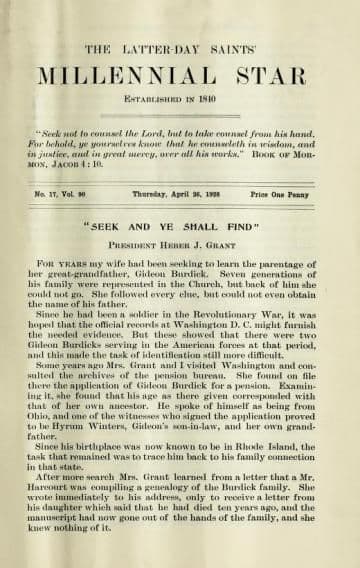Magazine
The Horse in Ancient America

Title
The Horse in Ancient America
Magazine
The Latter Day Saints' Millennial Star
Publication Type
Magazine Article
Year of Publication
1928
Editors
Widtsoe, John A. (Secondary)
Pagination
268–269
Date Published
26 April 1928
Volume
90
Issue Number
17
Abstract
Through historical, scientific, and scholarly evidence, this article argues that there were indeed horses in ancient America, well before Europeans first arrived. Nephi stated in the Book of Mormon that horses were found upon their arrival in the promised land.
THE HORSE IN ANCIENT AMERICA
The statement of Nephi that horses were found on this [the American] continent by Lehi’s colony when they came here has been used as an argument against the divine origin of the Book of Mormon; for, objectors have asserted that the horse was not known upon this continent until it was brought here by the Spaniards. In this way they have tried to prove the record to be false; but recent researches by scientific men have demonstrated beyond the possibility of doubt that America is the original home of the horse, and that at certain periods it was occupied with horses of many and various forms. Remains of the true horse, as we have it among us at the present time, have been found all over the land.
Professor 0. C. Marsh, whose patient and intelligent investigations have thrown a flood of light upon this subject, states that the true horse at one time roamed over the whole of North and South America. Nor do we believe that they had become extinct at the time of the coming of Columbus. It is asserted that the Spaniards found none of these animals in Mexico or Peru, but Sir Francis Drake saw bands of wild horses as he coasted along the shores of California and Oregon about 1579. Robert Dudley, Earl of Northumberland, published in 1630 at Florence, Italy, a book called Arcano del Mare. In it he states that Drake found that the savages of the country were very courteous and kind, and the land pretty fruitful, and the air temperate. He saw rabbits in great numbers, but with tails as long as [those of] rats, [saw] many 'wild horses, with the more wonder because the Spaniards never saw horses in America.
It is customary to account for the immense herds of American horses on the assumption that the Spaniards introduced them. But if Drake and his companions saw these horses as described by Dudley, they could not have been descendants of Spanish horses; for no Spaniards had penetrated that country or been within hundreds of miles of it at the time of its discovery by Drake in 1579.
Viceroy Mendoza, who succeeded Cortez by appointment of the Emporer Charles in the civil administration of the Spanish possessions, sent out Vasquez de Coronado to find the Seven Cities of Cibola, of the wealth of which the Spaniards had heard very wonderful stories. As early as 1540 he penetrated the country as far as the territory now known as New Mexico and probably into Arizona. He and his troops had horses; but even if they had lost or turned loose any, it is most improbable that in thirty-nine years they would have multiplied into large herds observed by Drake on the sea board, which, as we know, was at least five hundred miles away. Coronado had but few horses, would have had fewer brood mares and would have been apt to mention any loss of a large number of auxiliaries so essential to his expedition.—Deseret Sunday School Union Leaflets, February, 1896.
Subject Keywords
Bibliographic Citation
Terms of use
Items in the BMC Archive are made publicly available for non-commercial, private use. Inclusion within the BMC Archive does not imply endorsement. Items do not represent the official views of The Church of Jesus Christ of Latter-day Saints or of Book of Mormon Central.